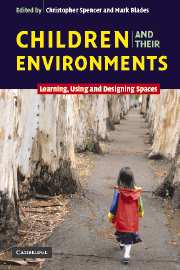Book contents
- Frontmatter
- Contents
- Notes on contributors
- An introduction
- Part I Children's understanding of places
- Part II Children's experience of places
- Part III Adolescents' worlds?
- Part IV Children and the design process
- 12 Children as agents in sustainable development: the ecology of competence
- 13 Children and city design: proactive process and the ‘renewal’ of childhood
- 14 A learning-based network approach to urban planning with young people
- 15 Young people's participation in constructing a socially just public sphere
- Index
- References
13 - Children and city design: proactive process and the ‘renewal’ of childhood
Published online by Cambridge University Press: 23 October 2009
- Frontmatter
- Contents
- Notes on contributors
- An introduction
- Part I Children's understanding of places
- Part II Children's experience of places
- Part III Adolescents' worlds?
- Part IV Children and the design process
- 12 Children as agents in sustainable development: the ecology of competence
- 13 Children and city design: proactive process and the ‘renewal’ of childhood
- 14 A learning-based network approach to urban planning with young people
- 15 Young people's participation in constructing a socially just public sphere
- Index
- References
Summary
I know we've come a long way. We're changing day to day. But tell me … where do the children play? – Yusuf Islam
(formerly Cat Stevens)How can designers and planners better engage children and youth and include their ideas in urban design? This chapter focuses on the culture of childhood today and the limits it places on meaningful children's participation in design and planning. We examine some of the ideas children themselves have about city form and suggest a more proactive process for city design. It is our hope that through more meaningful participation, critical aspects of childhood can be renewed, including children's access and reshaping of the built environment (Gaster, 1991; Perez and Hart, 1980).
We have previously developed a historical and critical review of children's participation in city planning and design over the last forty years (Francis and Lorenzo, 2002). We suggested that participatory efforts with children can be viewed in at least seven distinct approaches or ‘realms’ – advocacy, romantic, needs, learning, rights, institutionalization, and proactive (see Table 13.1). The proactive realm is seen as the most integrative and effective way to involve children and youth in design and planning. At the same time, this approach can also help create places that better satisfy the needs of all citizens including children. It can, we believe, activate a process of childhood renewal rendering local environments, and entire cities, accessible, comprehensible and friendly to children of all ages.
- Type
- Chapter
- Information
- Children and their EnvironmentsLearning, Using and Designing Spaces, pp. 217 - 237Publisher: Cambridge University PressPrint publication year: 2006
References
- 28
- Cited by

